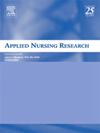Predictors and clinical implications of emotional distress on the day of discharge in hospitalized patients
IF 2.7
4区 医学
Q1 NURSING
引用次数: 0
Abstract
Objective
Emotional distress significantly affects the quality of life and mental health of hospitalized patients after discharge. This study aimed to identify key predictors of emotional distress on discharge day to inform clinical interventions.
Methods
A descriptive correlational design was employed, retrospectively analyzing the medical records of 73,814 inpatients from a medical center in southern Taiwan over two years and four months, encompassing 471,339 person-days of emotional distress assessments.
Results
The prevalence of emotional distress on discharge day was 73.1 %. Emotional distress on discharge day was positively correlated with age, hospital stay length, pain levels, and emotional distress on admission and during hospitalization. Women reported significantly higher emotional distress levels than men. Internal medicine patients exhibited significantly higher emotional distress levels compared to surgical and gynecological patients, while gynecological patients reported higher levels than surgical patients. Multivariate regression analysis identified seven significant predictors of emotional distress on the day of discharge: emotional distress on the day of admission (B = 0.470), internal medicine vs. surgery (B = 0.260), pain levels on the day of discharge (B = 0.110), age (B = 0.002), gynecology vs. surgery (B = 0.125), male vs. female gender (B = −0.038), and emotional distress during hospitalization (B = 0.012), all of which were statistically significant (p < .001).
Conclusion
Addressing emotional distress during hospitalization is essential to mitigating its persistence at discharge. Interventions should prioritize effective pain management, gender-sensitive care, and disease-specific strategies to enhance post-discharge quality of life and reduce the risk of readmission.
住院患者出院当天情绪困扰的预测因素及临床意义
目的情绪困扰显著影响住院患者出院后的生活质量和心理健康。本研究旨在找出出院当天情绪困扰的主要预测因素,为临床干预提供依据。方法采用描述性相关设计,回顾性分析台湾南部某医疗中心73,814名住院患者2年零4个月的病历资料,其中包括471,339人日的情绪困扰评估。结果出院当天情绪困扰发生率为73.1%。出院当天的情绪困扰与年龄、住院时间、疼痛程度、入院及住院期间的情绪困扰呈正相关。女性报告的情绪困扰程度明显高于男性。内科患者的情绪困扰水平明显高于外科和妇科患者,而妇科患者的情绪困扰水平高于外科患者。多因素回归分析发现出院当天情绪困扰的7个显著预测因子:入院当天情绪困扰(B = 0.470)、内科与外科(B = 0.260)、出院当天疼痛程度(B = 0.110)、年龄(B = 0.002)、妇科与外科(B = 0.125)、男性与女性(B = - 0.038)、住院期间情绪困扰(B = 0.012),均有统计学意义(p <;措施)。结论治疗住院期间的情绪困扰是缓解出院时持续存在情绪困扰的关键。干预措施应优先考虑有效的疼痛管理、性别敏感护理和疾病特异性策略,以提高出院后的生活质量并降低再入院风险。
本文章由计算机程序翻译,如有差异,请以英文原文为准。
求助全文
约1分钟内获得全文
求助全文
来源期刊

Applied Nursing Research
医学-护理
CiteScore
4.50
自引率
0.00%
发文量
65
审稿时长
70 days
期刊介绍:
Applied Nursing Research presents original, peer-reviewed research findings clearly and directly for clinical applications in all nursing specialties. Regular features include "Ask the Experts," research briefs, clinical methods, book reviews, news and announcements, and an editorial section. Applied Nursing Research covers such areas as pain management, patient education, discharge planning, nursing diagnosis, job stress in nursing, nursing influence on length of hospital stay, and nurse/physician collaboration.
 求助内容:
求助内容: 应助结果提醒方式:
应助结果提醒方式:


